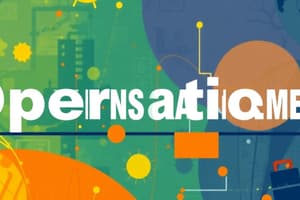Podcast
Questions and Answers
Which of the following best describes the core concept of 'Operations' in a business context?
Which of the following best describes the core concept of 'Operations' in a business context?
- The financial activities related to budgeting, accounting, and investment.
- The management of resources and processes to produce and deliver goods and services. (correct)
- The strategic planning involved in setting long-term goals for the organization.
- The process of marketing and selling goods and services to customers.
In the context of operations, 'inputs' are transformed into 'outputs.' Which of the following is typically considered an input?
In the context of operations, 'inputs' are transformed into 'outputs.' Which of the following is typically considered an input?
- Finished goods ready for sale.
- Raw materials used in production. (correct)
- Delivered services to customers.
- Profits generated from sales activities.
Which of the following correctly sequences the stages of transforming inputs into outputs?
Which of the following correctly sequences the stages of transforming inputs into outputs?
- Transformation -> Inputs -> Outputs
- Inputs -> Outputs -> Transformation
- Inputs -> Transformation -> Outputs (correct)
- Outputs -> Transformation -> Inputs
What is the primary focus of the 'Direct' stage in a business's operational cycle?
What is the primary focus of the 'Direct' stage in a business's operational cycle?
Which of the following activities is most aligned with the 'Design' phase of operations management?
Which of the following activities is most aligned with the 'Design' phase of operations management?
In the context of operations management, what does the 'Develop' stage primarily aim to achieve?
In the context of operations management, what does the 'Develop' stage primarily aim to achieve?
The 'Deliver' stage of operations management is characterized by which activity?
The 'Deliver' stage of operations management is characterized by which activity?
Which aspect of operations management directly addresses the planning and execution of project timelines?
Which aspect of operations management directly addresses the planning and execution of project timelines?
The 'Bullwhip Effect' is most closely associated with challenges in which area of operations management?
The 'Bullwhip Effect' is most closely associated with challenges in which area of operations management?
What is the primary goal of 'Lean Operations'?
What is the primary goal of 'Lean Operations'?
What does JIT, as a concept in operations, aim to achieve?
What does JIT, as a concept in operations, aim to achieve?
Which of the following activities falls under the umbrella of operations management?
Which of the following activities falls under the umbrella of operations management?
In the context of Table 1.1, which activity BEST showcases the application of operations management in a fast-food chain?
In the context of Table 1.1, which activity BEST showcases the application of operations management in a fast-food chain?
What is the BEST definition of Operations Management?
What is the BEST definition of Operations Management?
What is the difference between 'transforming resources' and 'transformed resources'?
What is the difference between 'transforming resources' and 'transformed resources'?
As described in Table 1.2, what BEST describes the main input of a 'warehouses' business?
As described in Table 1.2, what BEST describes the main input of a 'warehouses' business?
What is the primary distinction between a product and a service in the context of operations?
What is the primary distinction between a product and a service in the context of operations?
What does the IHIP characteristic 'Intangibility' mean?
What does the IHIP characteristic 'Intangibility' mean?
What does the IHIP characteristic 'Heterogeneity' mean?
What does the IHIP characteristic 'Heterogeneity' mean?
What does the IHIP characteristic 'Inseparability' mean?
What does the IHIP characteristic 'Inseparability' mean?
What does the IHIP characteristic 'Perishability' mean?
What does the IHIP characteristic 'Perishability' mean?
In the hierarchy of operations, which level focuses on the overall network of suppliers and distributors?
In the hierarchy of operations, which level focuses on the overall network of suppliers and distributors?
Within the hierarchy of operations, what does 'Operations Flow' primarily concern itself with?
Within the hierarchy of operations, what does 'Operations Flow' primarily concern itself with?
At which level of the operations hierarchy would you typically analyze the specific sequence of actions taken by a worker assembling a product?
At which level of the operations hierarchy would you typically analyze the specific sequence of actions taken by a worker assembling a product?
When considering the '4 Vs' of operations, what does 'Volume' refer to?
When considering the '4 Vs' of operations, what does 'Volume' refer to?
Flashcards
What are 'Operations'?
What are 'Operations'?
The activity of managing resources and processes to produce and deliver goods and services.
What are Transformed Resources?
What are Transformed Resources?
Resources like materials, information, and customers that are transformed in operations.
What are Transforming Resources?
What are Transforming Resources?
Resources like facilities and staff that act upon transformed resources.
What is Operations Management (OM)?
What is Operations Management (OM)?
Signup and view all the flashcards
What entails Operations Management?
What entails Operations Management?
Signup and view all the flashcards
What is Physician's surgery?
What is Physician's surgery?
Signup and view all the flashcards
What is Automobile assembly factory?
What is Automobile assembly factory?
Signup and view all the flashcards
What is Management consultancy?
What is Management consultancy?
Signup and view all the flashcards
What is Disaster relief charity?
What is Disaster relief charity?
Signup and view all the flashcards
Advertising agency?
Advertising agency?
Signup and view all the flashcards
What is Operations Management?
What is Operations Management?
Signup and view all the flashcards
What is Intangibility?
What is Intangibility?
Signup and view all the flashcards
What is Heterogeneity?
What is Heterogeneity?
Signup and view all the flashcards
What is Inseparability?
What is Inseparability?
Signup and view all the flashcards
What is Perishability?
What is Perishability?
Signup and view all the flashcards
What is Hierarchy of Operations?
What is Hierarchy of Operations?
Signup and view all the flashcards
The Supply Network
The Supply Network
Signup and view all the flashcards
The Operations
The Operations
Signup and view all the flashcards
The Processes
The Processes
Signup and view all the flashcards
Study Notes
- Nigel Slack , Alistair Brandon-Jones and Nicola Burgess wrote "Operations Management"
- Dr. Mohammed El-Beheiry
What is Operations?
- Operations manages resources and processes to produce and deliver goods and services
- Operations transforms resource inputs into product and service outputs
- This process is called the ‘input-transformation output’ model of operations
Business Operations
- Direct: steering operations and processes
- Design: shaping processes, products, and services
- Develop: improving operations capabilities
- Deliver: Planning and controlling ongoing operations, adding value for customers
Topics Covered
- Introduction to operations management and operations strategy
- Product development, process and capacity design
- Demand forecasting
- Process design for services and manufacturing
- Quality management
- Introduction to supply chains and the Bullwhip Effect
- Planning and Control – Sequencing/Scheduling of operations
- Overview of the materials planning process
- Lean Operations and Just-in-Time (JIT)
- Facility layout and location
- Operations improvement and international operations management
Course Grade Breakdown
- Course Project (Group Project) is 20%
- Quizzes (2 Quizzes) are 15%
- Mid-Term Exam is 25%
- Final Exam is 40%
Operations Management (OM) definition
- The business function plans, organizes, coordinates, and controls to produce a company’s goods and services
The Transformation Process
- Transforming resources are people and facilities
- Transformed resources are materials, information, and customers
Outputs
- Operations creates products and services
- Products are physical things
- Services are activities or processes
IHIP Characteristics
- Used to distinguish the different types of output
- Intangibility means it is difficult to define the boundary of service
- Heterogeneity means every service is different, difficult to standardize, and may be outside operational capabilities
- Inseparability means the production and consumption are simultaneous, requiring sufficient capacity to meet demand
- Perishability means operations are difficult to store, and cease to have value after a short time
Goods vs Services
| Characteristic | Goods | Service |
|---|---|---|
| Output | Tangible | Intangible |
| Customer contact | Low | High |
| Uniformity of input | High | Low |
| Labor content | Low | High |
| Uniformity of output | High | Low |
| Measurement of productivity | Easy | Difficult |
| Opportunity to correct quality problems | High | Low |
Hierarchy of Operations
- Supply Chain
- Operations Flow
- Process Flow
Operations: Supply Network
- Supply Network flows between operations
- Operations flows between processes
- Processes flow between resources (people or facilities)
Operations Typology
| Characteristic | Low | High |
|---|---|---|
| Volume of output | Low | High |
| Variety | High | Low |
| Variation | High | Low |
| Visibility | High | Low |
Implications according to Typology
| Low | High | |
|---|---|---|
| Volume | Low Repetition, Each Staff Member Performs More of Job, Less Systemization, High Units cost | High Repeatability, Specialization Capital Intensive, Low unit costs |
| Variety | Flexible, Complex, Match Customer Needs, High Unit Costs | Well-Defined, Routine, Standardized, Regular, Low Unit Costs |
| Variation | Changing Capacity, Anticipation, Flexibility, In-Touch With Demand, High Unit Costs | Stable, Routine, Predictable, High Utilization, Low Unit Costs |
| Visibility | Short Waiting Tolerance, Satisfaction Governed By Customer Perception, Customer Contact Skills Needed, Received Variety Is High, High Unit Costs | Time Lag Between Production and Consumption, Standardization, Low Contact Skills, High Staff Utilization, Centralization, Low Unit Costs |
Key questions
- Important to understand how different operations are positioned on the 4 Vs
- Is their position where they want to be?
- Do they understand the strategic implications?
Studying That Suits You
Use AI to generate personalized quizzes and flashcards to suit your learning preferences.




